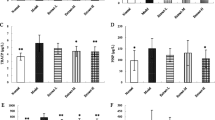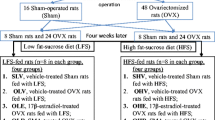Abstract
Osteoporosis is a chronic disease affecting millions of people worldwide. It is generally accepted that acquisition of a high peak bone mass (PBM) early in life can reduce the risk of osteoporosis later in life. The aims of this study were to investigate the effects of Fructus Ligustri Lucidi (FLL) ethanol extract on bone mineral density and its mechanical properties in growing female rats and to explore the underlying mechanisms. The rats were given different doses of FLL extract mixed with AIN-93G formula (0.40, 0.65 and 0.90 %), and a group given AIN-93G diet treatment only was used as control. The intervention lasted for 16 weeks until the animals were about 5 months old, the time when the animals almost reach their PBM. Our results showed that FLL treatment increased bone mineral density and improved bone mechanical properties in the growing female rats in a dose-dependent manner. In addition, FLL treatment significantly decreased the serum bone-resorbing marker, CTX-I, while significantly increasing serum 25(OH)D3 and thereby increasing Ca absorption and Ca retention. Intriguingly, both in vivo and in vitro results demonstrated that FLL treatment could reduce the RANKL/OPG ratio. In conclusion, FLL ethanol extract exerted beneficial effects on peak bone mass acquisition and the improvement of bone mechanical properties by favoring Ca metabolism and decreasing the RANKL/OPG ratio.







Similar content being viewed by others
References
WHO (2003) Prevention and management of osteoporosis. World Health Organ Tech Rep Ser 921:1–164
NIH (2001) NIH consensus development panel on osteoporosis prevention, diagnosis, and therapy, March 7–29, 2000: highlights of the conference. South Med J 94:569–573
Brunader R, Shelton DK (2002) Radiologic bone assessment in the evaluation of osteoporosis. Am Fam Physician 65:1357–1364
Xue K, Ren-hui L, **u-juan W (2012) Advances on studies of anti-osteoporosis applications and mechanisms by Herba Epimedii and Fructus ligustri lucidi. Chin J Exp Tradit Med Formulae 18:331–334
Zhang Y, Lai WP, Leung PC, Wu CF, Yao XS, Wong MS (2006) Effects of Fructus ligustri lucidi extract on bone turnover and calcium balance in ovariectomized rats. Biol Pharm Bull 29:291–296
Zhang Y, Dong XL, Leung PC, Che CT, Wong MS (2008) Fructus ligustri lucidi extract improves calcium balance and modulates the calciotropic hormone level and vitamin D-dependent gene expression in aged ovariectomized rats. Menopause 15:558–565
Zhang Y, Leung PC, Che CT, Chow HK, Wu CF, Wong MS (2008) Improvement of bone properties and enhancement of mineralization by ethanol extract of Fructus ligustri lucidi. Br J Nutr 99:494–502
Zhu K, Prince RL (2012) Calcium and bone. Clin Biochem 45:936–942
Lane NE (2006) Epidemiology, etiology, and diagnosis of osteoporosis. Am J Obstet Gynecol 194:S3–S11
Peterson CA, Eurell JA, Erdman JJ (1995) Alterations in calcium intake on peak bone mass in the female rat. J Bone Miner Res 10:81–95
Sengupta S, Arshad M, Sharma S, Dubey M, Singh MM (2005) Attainment of peak bone mass and bone turnover rate in relation to estrous cycle, pregnancy and lactation in colony-bred Sprague–Dawley rats: suitability for studies on pathophysiology of bone and therapeutic measures for its management. J Steroid Biochem Mol Biol 94:421–429
Li G, Zhang XA, Zhang JF, Chan CY, Yew DT, He ML, Lin MC, Leung PC, Kung HF (2010) Ethanol extract of Fructus ligustri lucidi promotes osteogenesis of mesenchymal stem cells. Phytother Res 24:571–576
Christakos S, Dhawan P, Porta A, Mady LJ, Seth T (2011) Vitamin D and intestinal calcium absorption. Mol Cell Endocrinol 347:25–29
Bronner F (2009) Recent developments in intestinal calcium absorption. Nutr Rev 67:109–113
Fleet JC, Schoch RD (2010) Molecular mechanisms for regulation of intestinal calcium absorption by vitamin D and other factors. Crit Rev Clin Lab Sci 47:181–195
Miller WL, Portale AA (2000) Vitamin D 1 alpha-hydroxylase. Trends Endocrinol Metab 11:315–319
Bikle DD (2012) Vitamin D and bone. Curr Osteoporos Rep 10:151–159
Cole JH, van der Meulen MC (2011) Whole bone mechanics and bone quality. Clin Orthop Relat Res 469:2139–2149
Friedman AW (2006) Important determinants of bone strength: beyond bone mineral density. J Clin Rheumatol 12:70–77
van der Meulen MC, Boskey AL (2012) Atypical subtrochanteric femoral shaft fractures: role for mechanics and bone quality. Arthritis Res Ther 14:220
Chen H, Zhou X, Fujita H, Onozuka M, Kubo KY (2013) Age-related changes in trabecular and cortical bone microstructure. Int J Endocrinol 2013:213234
Srivastava K, Khan K, Tyagi AM, Khan MP, Yadav DK, Trivedi R, Maurya R, Singh D, Chattopadhyay N (2013) Greater skeletal gains in ovary intact rats at maturity are achieved by Supplementing a standardized extract of Butea monosperma stem bark that confers better bone conserving effect following ovariectomy and concurrent treatment withdrawal. Evid Based Complement Alternat Med 2013:519387
Perez-Sayans M, Somoza-Martin JM, Barros-Angueira F, Rey JM, Garcia-Garcia A (2010) RANK/RANKL/OPG role in distraction osteogenesis. Oral Surg Oral Med Oral Pathol Oral Radiol Endod 109:679–686
Bai YD, Yang FS, Xuan K, Bai YX, Wu BL (2008) Inhibition of RANK/RANKL signal transduction pathway: a promising approach for osteoporosis treatment. Med Hypotheses 71:256–258
Blair JM, Zheng Y, Dunstan CR (2007) RANK ligand. Int J Biochem Cell Biol 39:1077–1081
Boyce BF, **ng L (2007) Biology of RANK, RANKL, and osteoprotegerin. Arthritis Res Ther 9:S1
Hofbauer LC, Schoppet M (2004) Clinical implications of the osteoprotegerin/RANKL/RANK system for bone and vascular diseases. JAMA 292:490–495
Lee YS, Choi EM (2011) Costunolide stimulates the function of osteoblastic MC3T3-E1 cells. Int Immunopharmacol 11:712–718
Li F, Yang Y, Zhu P, Chen W, Qi D, Shi X, Zhang C, Yang Z, Li P (2012) Echinacoside promotes bone regeneration by increasing OPG/RANKL ratio in MC3T3-E1 cells. Fitoterapia 83:1443–1450
Vasikaran S, Eastell R, Bruyere O, Foldes AJ, Garnero P, Griesmacher A, McClung M, Morris HA, Silverman S, Trenti T, Wahl DA, Cooper C, Kanis JA (2011) Markers of bone turnover for the prediction of fracture risk and monitoring of osteoporosis treatment: a need for international reference standards. Osteoporos Int 22:391–420
Malaval L, Modrowski D, Gupta AK, Aubin JE (1994) Cellular expression of bone-related proteins during in vitro osteogenesis in rat bone marrow stromal cell cultures. J Cell Physiol 158:555–572
Wang D, Christensen K, Chawla K, **ao G, Krebsbach PH, Franceschi RT (1999) Isolation and characterization of MC3T3-E1 preosteoblast subclones with distinct in vitro and in vivo differentiation/mineralization potential. J Bone Miner Res 14:893–903
Li JF, Chen SJ, Zhao Y, Li JX (2009) Glycoside modification of oleanolic acid derivatives as a novel class of anti-osteoclast formation agents. Carbohydr Res 344:599–605
Li JF, Zhao Y, Cai MM, Li XF, Li JX (2009) Synthesis and evaluation of a novel series of heterocyclic oleanolic acid derivatives with anti-osteoclast formation activity. Eur J Med Chem 44:2796–2806
Zhang Y, Li JX, Zhao J, Wang SZ, Pan Y, Tanaka K, Kadota S (2005) Synthesis and activity of oleanolic acid derivatives, a novel class of inhibitors of osteoclast formation. Bioorg Med Chem Lett 15:1629–1632
Xu Y, Han X, Li Y (2010) Effect of marine collagen peptides on long bone development in growing rats. J Sci Food Agric 90:1485–1491
Conflict of interest
All authors have no conflicts of interest.
Author information
Authors and Affiliations
Corresponding authors
Additional information
Y. Lyu and X. Feng contributed equally to this work.
About this article
Cite this article
Lyu, Y., Feng, X., Zhao, P. et al. Fructus Ligustri Lucidi (FLL) ethanol extract increases bone mineral density and improves bone properties in growing female rats. J Bone Miner Metab 32, 616–626 (2014). https://doi.org/10.1007/s00774-013-0536-8
Received:
Accepted:
Published:
Issue Date:
DOI: https://doi.org/10.1007/s00774-013-0536-8




